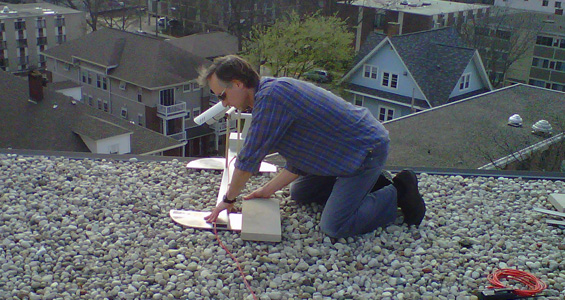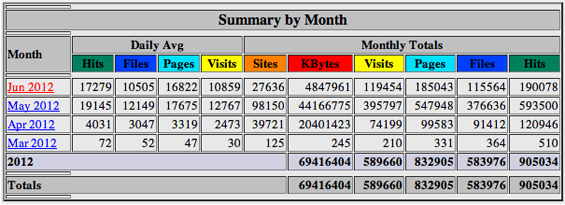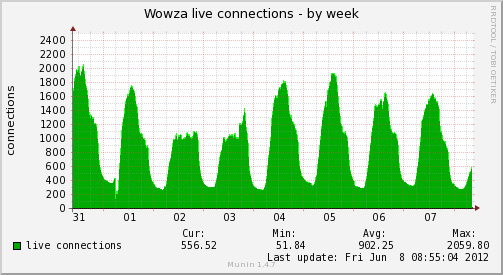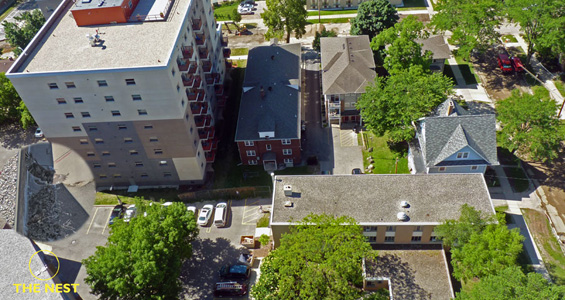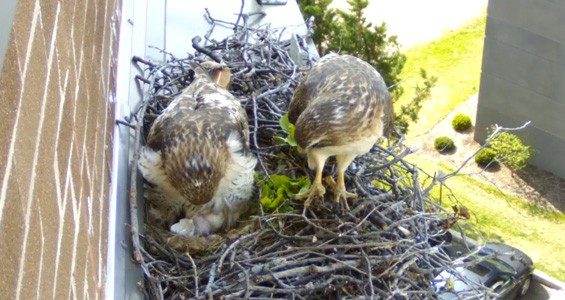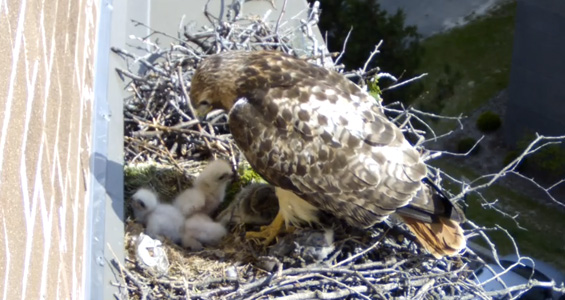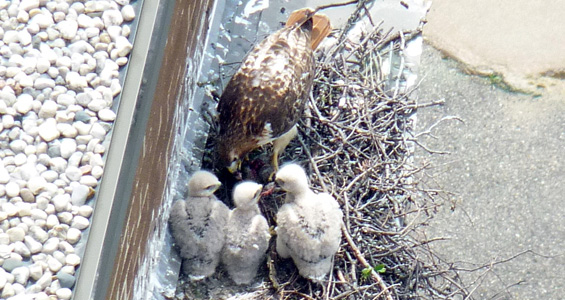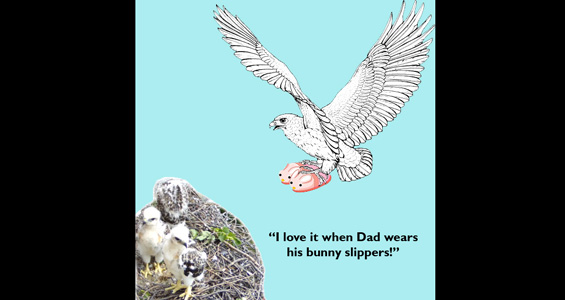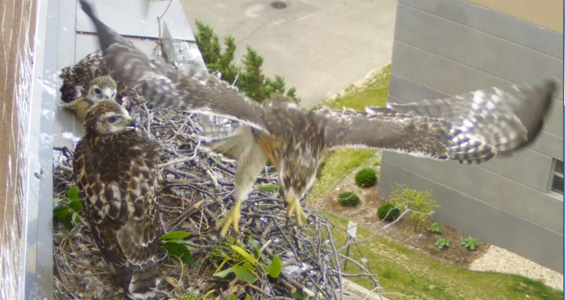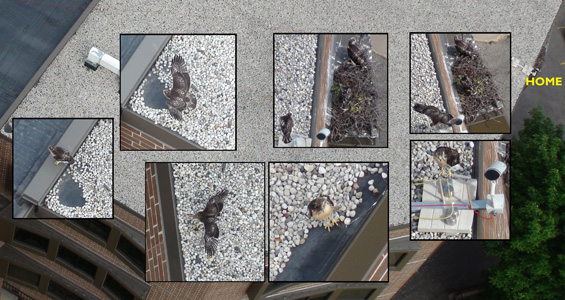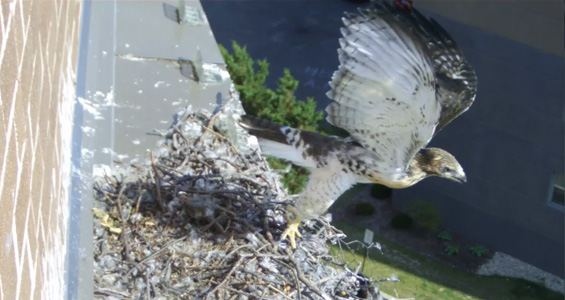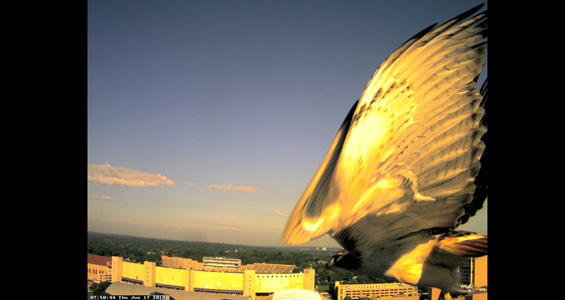“Empty Nest Syndrome” Strikes Hawk Cam
Over the past three months, the family of red-tailed hawks nesting atop the top floor window of Weeks Hall (Geology) on the UW-Madison campus has inspired literally hundreds of surrogate (human) parents worldwide to watch the eggs hatch, the three chicks grow, and finally take wing.
Timelapse video of the nest from eggs to fledging (compiled by Pete Pokrandt, UW-Madison AOS Dept.).
Inspired by the Web cam set up as a cooperative effort by SSEC and the Geology Department, hundreds of emailed questions, concerns, and comments flooded the SSEC in-boxes. Not being bona fide bird experts, the many responders at SSEC tried to answer some questions and calm some concerns, but for the most part they were simply watching the show as well. And what a show it was.
A bit of history: Two years ago, a pair of red-tailed hawks built a nest on the Weeks Hall window. Last year they returned and SSEC placed a small video camera to watch them hatch and fledge their young. This year a higher resolution camera has provided an even better view – and caught the internet “wave.” Our little family became famous overnight.
Nick Ciganovich installing the camera on the roof of Weeks Hall.
The equipment: The iQInvision Sentinel 865 camera was purchased for a project to record timelapse movies of cloud formations, from the roof of the Atmospheric, Oceanic & Space Sciences Building (SSEC’s home – a 16-floor structure right next door to Weeks Hall, with an excellent view of the nest). The camera is temporarily on-loan to provide video of the hawk’s nest. For the camera’s original function (rooftop cloud formation timelapse movies) camera resolution and durability were our primary concerns, which is why the camera does not have nightvision or sound.
The SSEC Youtube channel shows all of our hawkcam videos.
There were over 590,000 visits to the Hawkcam web page from when it went live, from 100 countries and all 50 states. The maximum number of simultaneous viewers was just over 2,000.
Live connections the week of 31 May 2012.
The hawks’ neighborhood (as seen from the roof of the AOSS Building on the UW campus.
The hawks: Red-tailed hawks reach sexual maturity at the age of three years and begin breeding. They are monogamous and usually only change mates if their original mate dies. A clutch of 1 to 3 eggs is laid in March or April, depending upon latitude. Clutch size depends almost exclusively on the availability of prey for the adults. Eggs are laid approximately every other day.
The female does most of the incubating, while the male supplies most of the food. The male will substitute on the nest when the female leaves to hunt or stretch her wings.
Proud parents watching their chicks hatch.
Shielding the little ones from the sun.
After an average of 28 to 35 days, the eggs hatch over a 2 to 4 day period. Our family started when two eggs hatched on April 19th and one on April 22th. Thousands of excited viewers watched the chicks feed and grow. As they grew, one of the chicks in particular seemed to lag a bit behind the other two in both size and health. Male hawk chicks tend to be smaller than the females, but differentiating between the sexes of red-tailed hawks is almost impossible from afar. Despite the concerns, the little one kept hanging in there.
Typically, after 42 to 46 days, the chicks begin to leave the nest on short flights. One of our three chicks left the nest at 6:59 a.m. on 30 May 2012. It looked to us as if it may have been blown off the nest while stretching its wings.
The first chick to leave the nest.
Check here for a look at its travels. It returned to the nest at 6:45 pm the same day.
The first chick spending its first day away from the nest — but not TOO far.
The second chick soon took flight and suspense built for days as the third chick, smaller in size than the other two, took its time in taking to the air. Then, with a deliberate spread of its wings, it too vanished from our camera’s view.
The third, and smallest, chick takes wing.
Their fledging period will last up to 10 weeks, during which the young will remain in the area, learning to fly and hunt. The red-tailed hawk lives an average of 10 to 20 years. They grow to weigh 2 to 4 pounds. The female is usually 25% bigger than the male. After their second year their tails turn red.
It has been an exciting few months. The hawks circle above the UW-Madison campus, often perching on SSEC’s satellite antennae atop the AOSS Building.
Soon they will strike out on their own. Their fate awaits them in the blue Wisconsin sky.
Thanks to:
- Ben Abernathy, Geoscience – network support.
- Bill Bellon, SSEC – web site & public outreach.
- Fred Best, SSEC – camera proposal and planning.
- Nick Ciganovich, SSEC – design, construction and installation of camera mount.
- Brian Hess, Geoscience – help with camera installation and roof access.
- John Lalande, SSEC – streaming media server setup & camera installation.
- Mark Hobson, SSEC – media relations and public outreach.
- Pete Pokrandt, AOS – video image capture and editing.
University of Wisconsin Division of Information Technology (DoIT) Data Center & Shared Computing Services group – server hosting.
Thanks to Chris Barncard at UW Communications for helpful answers and media contacts.
And a special thanks to Avian biologist Mark Berres, assistant professor of animal science at the UW-Madison College of Agricultural and Life Sciences, for his help in answering questions about hawks that satellite meteorologists, web programmers, and the like didn’t happen to know!

